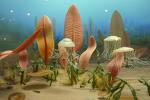 |
 |
 |
 |
 |
Produced
by the Population Genetics and Evolution class, Furman University |
||||
 |
 |
 |
 |
 |
Produced
by the Population Genetics and Evolution class, Furman University |
||||
 |
The
Ediacaran: The Doushantuo Formation |
 |
| The Doushantuo
Formation in Guizhou, South China is a 57 km^2, Neoproterozoic lagerstätte;
an area containing highly preserved, abundant fossil material currently
dated between 635-551 million years old (Condon et al. 2005). Discovered
in the late nineties, it is of particular interest because this date falls
before the Cambrian Explosion, possibly spanning 90% of the Ediacaran
period (Condon et al. 2005). The formation includes what may be embryos
and eggs of different animals, though that conclusion is still under debate
as some scientists contend that these small fossils may be other organic
or inorganic formations (Raff et al. 2006). Raff et al. (2006) argue that
the size of an embryo has little to do with how well it may be preserved,
so the Doushantuo Formation may indeed contain fossil evidence of some
of the very first bilaterians. The evolution of complex animals may have
been fostered by the rise in oxygen at this time (McFadden et al. 2010).
The site contains a variety of fossils, including marine algae, cnidarians,
protists, bacteria, archaebacteria, and the oldest recorded sponges (Clowes
2004). A possible factor in the high quality of the fossils (some can
even be studied at the cellular level and have been shown to have properties
very similar to some modern plants) is that the organisms may have been
buried alive and exposed to high levels of dissolved phosphate (Clowes
2004). All in all, the Doushantuo Formation is certainly one of the most
important finds in paleontology and evolutionary biology.
Page by Will Towler |
 |
| Putative fossil embryos from the Doushantuo Formation;
note possible bilateralism. Field view approx. 0.15 mm width. Photo from
PhysOrg.com. |
|
| Clowes
C. 2004. Doushantuo Formation. www.peripatus.gen.nz. Accessed Jan
24, 2010.
McFadden KA, Huang J, Chu X, Jiang G, Kaufman AJ Zhou C, Yuan X, Xiao S. 2008. Pulsed oxidation and biological evolution in the Ediacaran Doushantuo Formation. PNAS 105: 3197-3202. Raff E, Villinski J, Turner F, Donoghue P, Raff R. 2006. Experimental taphonomy shows the feasibility of fossil embryos. PNAS 103: 5846-5851. Condon D, Zhu M, Bowring S, Wang W, Yang A, Jin Y. 2005. U-Pb ages from the Neoproterozoic Doushantuo Formation, China. Science 308: 95-98. |